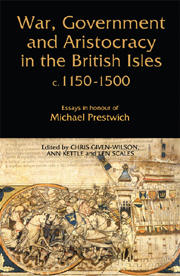 War, Government and Aristocracy in the British Isles, c.1150–1500
War, Government and Aristocracy in the British Isles, c.1150–1500 Book contents
- Frontmatter
- Contents
- List of Contributors
- Introduction
- Abbreviations
- Did Henry II Have a Policy Towards the Earls?
- The Career of Godfrey of Crowcombe: Household Knight of King John and Steward of King Henry III
- Under-Sheriffs, The State and Local Society c.1300–1340: A Preliminary Survey
- Revisiting Norham, May–June 1291
- Treason, Feud and the Growth of State Violence: Edward I and the ‘War of the Earl of Carrick’, 1306–7
- The Commendatio Lamentabilis for Edward I and Plantagenet Kingship
- Historians, Aristocrats and Plantagenet Ireland, 1200–1360
- War and Peace: A Knight's Tale. The Ethics of War in Sir Thomas Gray's Scalacronica
- The King's Secrets: Richard de Bury and the Monarchy of Edward III
- Budgeting at the Medieval Exchequer
- Recent Scholarship on Crusading and Medieval Warfare, 1095–1291: Convergence and Divergence
- The Military Ordinances of Henry V: Texts and Contexts
- Chivalry and English Kingship in the Later Middle Ages
- Cloth of Gold and Gold Thread: Luxury Imports to England in the Fourteenth Century
- Bibliography of the Writings of Michael Prestwich
- Index
- Tabula Gratulatoriad
The King's Secrets: Richard de Bury and the Monarchy of Edward III
Published online by Cambridge University Press: 12 September 2012
- Frontmatter
- Contents
- List of Contributors
- Introduction
- Abbreviations
- Did Henry II Have a Policy Towards the Earls?
- The Career of Godfrey of Crowcombe: Household Knight of King John and Steward of King Henry III
- Under-Sheriffs, The State and Local Society c.1300–1340: A Preliminary Survey
- Revisiting Norham, May–June 1291
- Treason, Feud and the Growth of State Violence: Edward I and the ‘War of the Earl of Carrick’, 1306–7
- The Commendatio Lamentabilis for Edward I and Plantagenet Kingship
- Historians, Aristocrats and Plantagenet Ireland, 1200–1360
- War and Peace: A Knight's Tale. The Ethics of War in Sir Thomas Gray's Scalacronica
- The King's Secrets: Richard de Bury and the Monarchy of Edward III
- Budgeting at the Medieval Exchequer
- Recent Scholarship on Crusading and Medieval Warfare, 1095–1291: Convergence and Divergence
- The Military Ordinances of Henry V: Texts and Contexts
- Chivalry and English Kingship in the Later Middle Ages
- Cloth of Gold and Gold Thread: Luxury Imports to England in the Fourteenth Century
- Bibliography of the Writings of Michael Prestwich
- Index
- Tabula Gratulatoriad
Summary
The statecraft of Edward III is a subject that has been much in discussion over the last two generations, as historians have begun to recognize the achievement of this king in effecting a remarkable rapprochement between the ambitions of the crown and the interests of the political community. Secrecy is not one of the more obvious attributes of this politique: as Michael Prestwich has done so much to demonstrate, Edward III's popularity and effectiveness relied in no small way on his practice of open government and his recognition, both rhetorically and substantively, of the benefits of public debate. In other respects, however, it is very clear that Edward understood the strategic importance of confidentiality and subterfuge. In 1330 he and a small group of household retainers hatched the secret plot that allowed them to ambush Roger Mortimer at Nottingham Castle and restore the young king to rightful power. In 1331, the king travelled in disguise as a pilgrim on a secret mission to the continent for discussions with Philip VI of France. In 1340 he arrived back in England unannounced from a long period of absence on the continent in order to catch the domestic administration unawares and punish those whom he saw as abusing his trust. In 1344–6, Edward planned the major campaign that would culminate in the victories of Crécy and Calais under a strict code of confidentiality, such that even at the point of departure some of his major commanders had no idea as to where the royal armada was intending to sail.
- Type
- Chapter
- Information
- War, Government and Aristocracy in the British Isles, c.1150–1500Essays in Honour of Michael Prestwich, pp. 163 - 178Publisher: Boydell & BrewerPrint publication year: 2008
